#TBT Omega Speedmaster Mark II 145.014 with Racing Dial
The Omega Speedmaster Mark II
It was at least ten years ago that I stumbled upon a very rudimentary website depicting a chronology of wild, boldly styled 1970’s Omega chronographs and I enjoyed marveling at them, but one stuck out as especially notable: the Omega Speedmaster Mark II 145.014. Yes, amongst all of the crazy flying saucer-esque, deeply cased oddities, it was the Omega Speedmaster Mark II that caught my eye. However, priorities changed, time dragged on and I resisted buying one, or even seriously looking for one, for a long, long time. And then – I snapped one up and haven’t regretted it since. Today’s #TBT takes a look at this revolutionary watch, briefly details its restoration, and doles out some proper plain old admiration for a watch that was significant enough to warrant a serial production reissue within the last couple years from Omega.
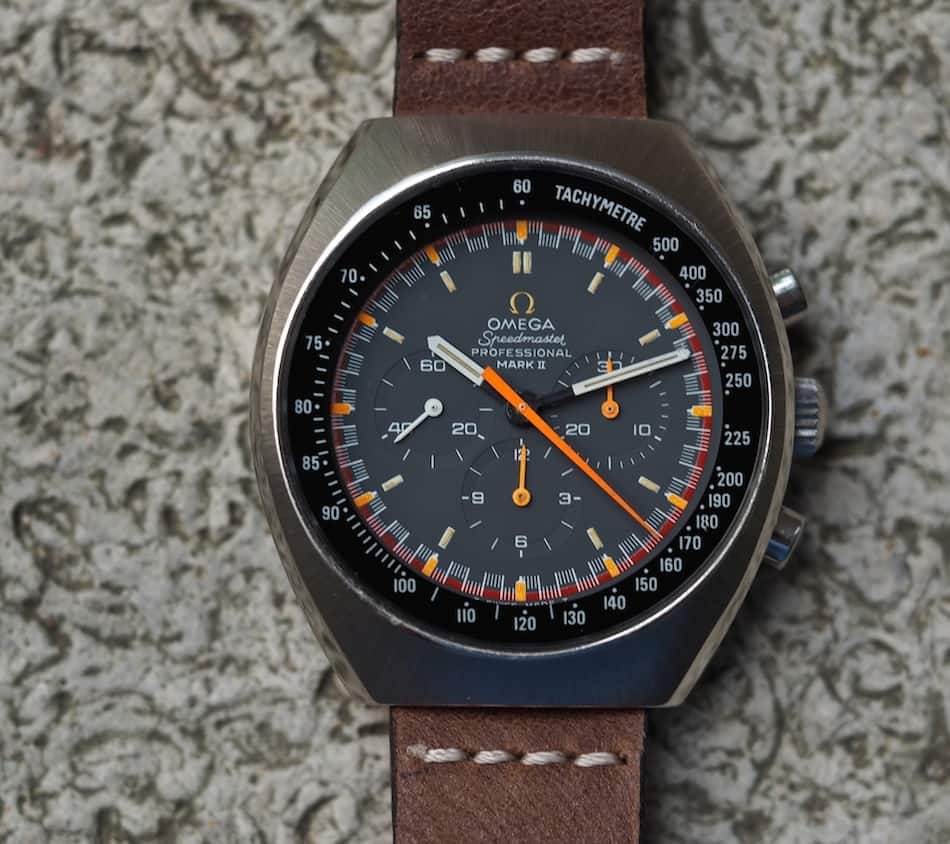
There’s the Moonwatch…and everything else
When it comes to vintage Speedmasters, it seems that everything basically falls off the radar screen after the mention of the Moonwatch. I’d even argue that almost everything “post-moon” under the Moonwatch title in steel finds itself riding in steerage aside from a few notable exceptions such as “straight writing” case backs or limited editions. So, when it comes to the offspring of the Professional such as the Omega Speedmaster Mark II 145.014, these have generally been viewed as estranged family members and values have remained at amazingly affordable levels. But at least in the case of the Speedy II, its status as a comparatively unloved watch that has hidden in the shadow of its more accomplished ancestor almost didn’t happen.
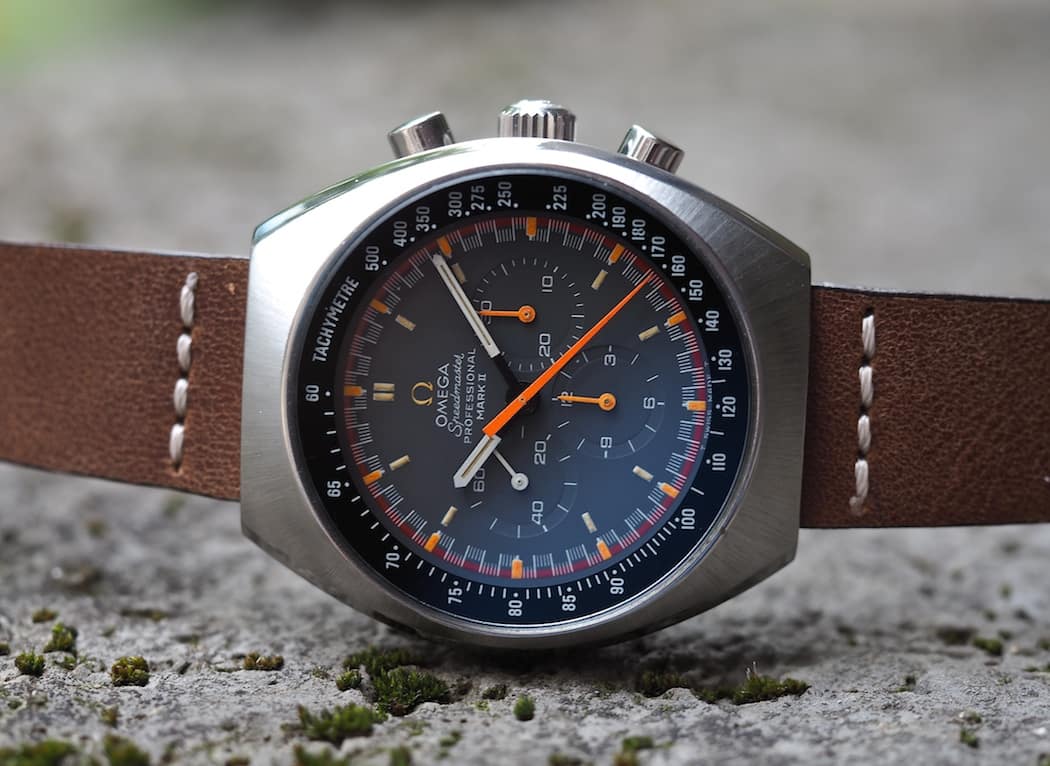
Omega Speedmaster Mark II 145.014 was meant for more
Omega wasn’t keen to rest on its laurels of being the official watch used by NASA’s astronauts. The story apparently points to the fact that Omega wanted to follow up or supplement the Moonwatch with something more modern and purpose built to the needs of a space explorer and they wished to do it under the Professional moniker. The result, launched in 1969, was the Omega Speedmaster Mark II 145.014. With its smooth case, stronger and a more flush mounted mineral crystal, it definitely looks more apt for the job. According to lore, NASA was approached to take a look at the new Speedy but apparently could not fit the testing into its tight mission scheduling. Furthermore, and this is pure conjecture as I am an engineer, but I’d guess that NASA also took a “if it’s not broke, don’t fix it approach”. It is worth pondering, if only for a few moments, how different the collector view on the Omega Speedmaster Mark II would be today had it been indoctrinated as an official mission watch. Interestingly, Omega did seem to continue to push the Speedmaster Mark II as a possible space watch during its famous, and ultimately doomed, Alaska Project testing.
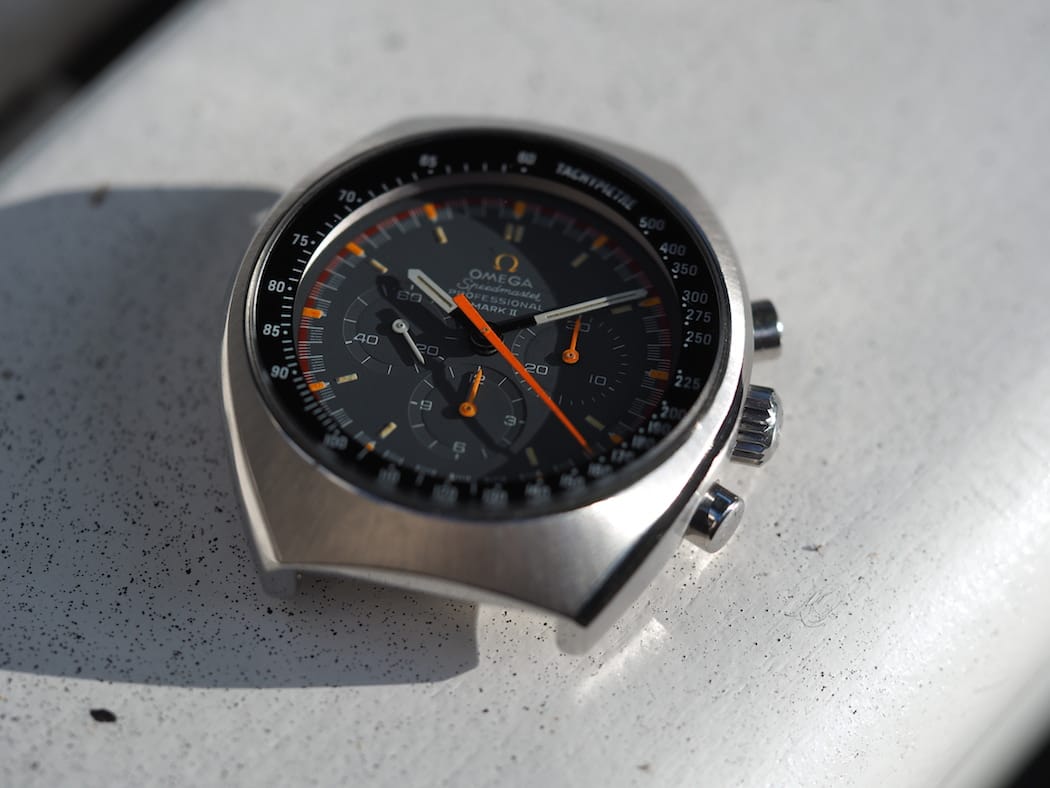
But the Mark II is still highly significant
Perhaps unknowingly, though, the Omega Speedmaster Mark II 145.014 did have a far greater effect on the general watch market. Quite simply, most credit the Speedy Mark II with ushering in, or at least making popular, the so-called C-Case, tonneau, or cushion-shaped watch that became absolutely symbolic of 1970’s watches the world over. Simultaneously, it also helped kill off the bulk of the traditional round-cased chronographs from the 1960’s that collectors now truly adore. All in the name of progress, right?
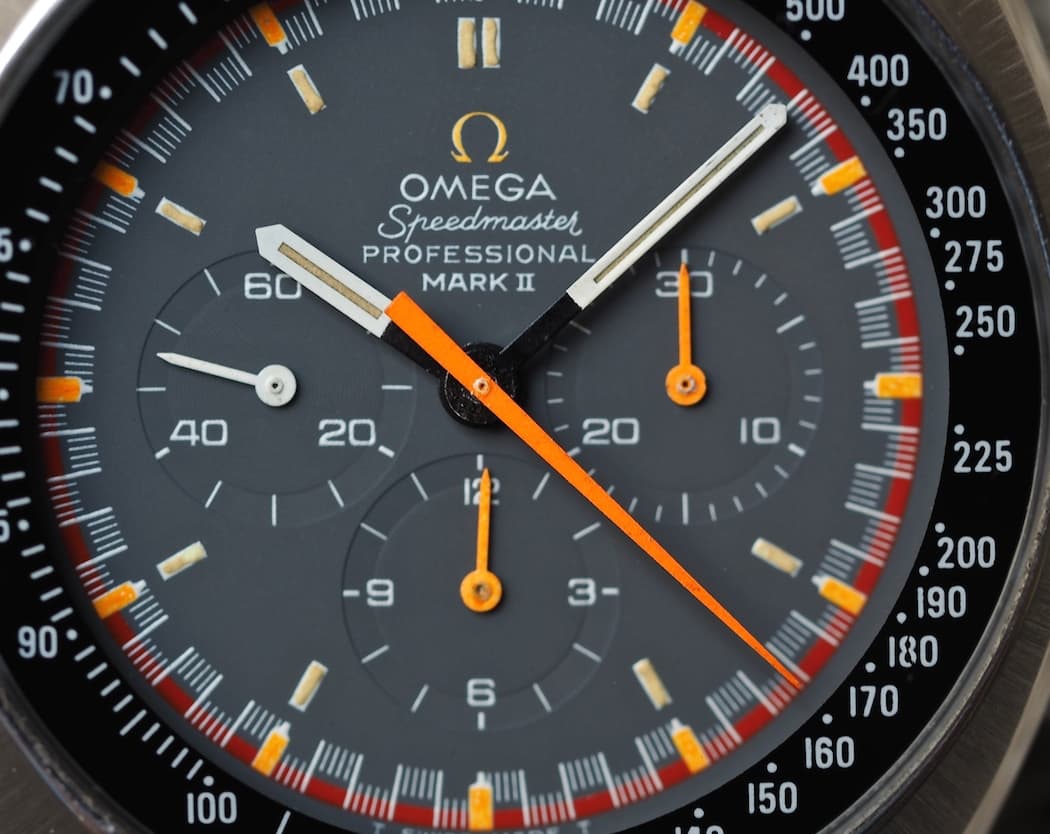
Racing dials are hot!
On multiple occasions, I’ve stated my general disdain for 1970’s chronographs. In a nutshell, I tend to find C-cases passé and in that awkward state where they’re not timeless but they yet they are now vintage. I’ve softened a bit, though, since I do love 70’s Seikos and I’m head over heels in love with the Roamer Stingray I recently featured. But the Omega Speedmaster Mark II 145.014, despite its significance design-wise, is too boring a design to garner much favor from me, correct? Not so fast. You see, Omega issued three different Speedy Mark II’s. They issued gold plated version with gold dial and burgundy bezel, a black-dialed version similar to the traditional Moonwatch (Robert-Jan owns a lovely example and Blaise has owned one as well) and then –they issued a racing dial version. It was this exotic dial that finally sold me on owning a Speedy II.
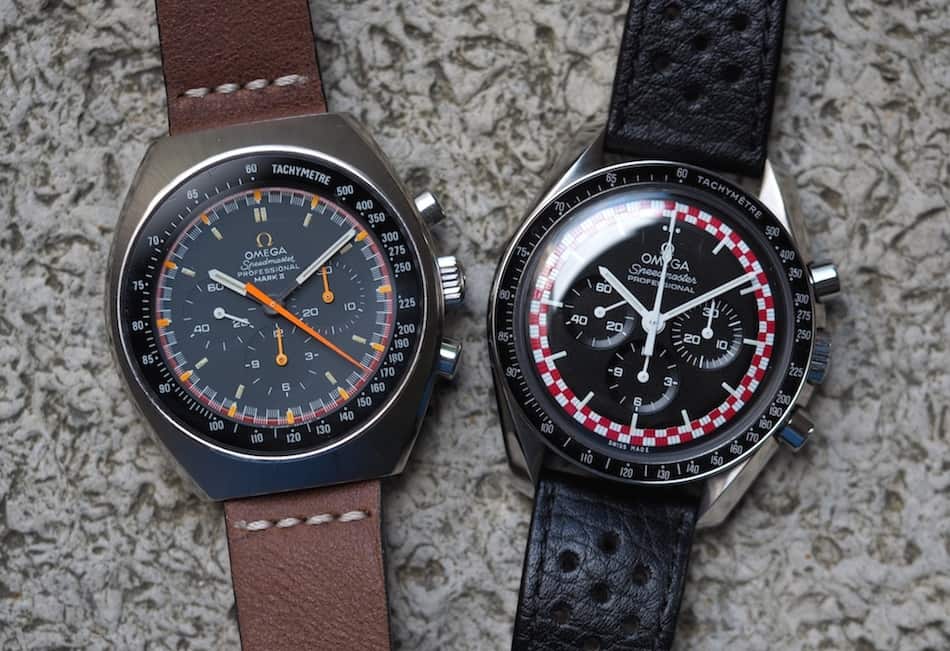
Racing dialed Omega Speedmasters are a special sub-genre. We’ve featured the vintage versions, found in the traditional Speedmaster case, in several SpeedyTuesday articles here on Fratello. These watches are expensive and extremely rare with prices often cresting the $50,000 mark. Omega reissued a thematically similar piece for the Japan market in 2004 as a special edition and these are now becoming quite desirable too. More recently, the so-called “TinTin”, which has a cult following, was made briefly by Omega only a few years ago. The Omega Speedmaster Mark II 145.014, though, combines the startling looks of the early Moonwatch-cased racing dials into its unique case and as we will discuss later, it’s an amazingly easy watch to locate.
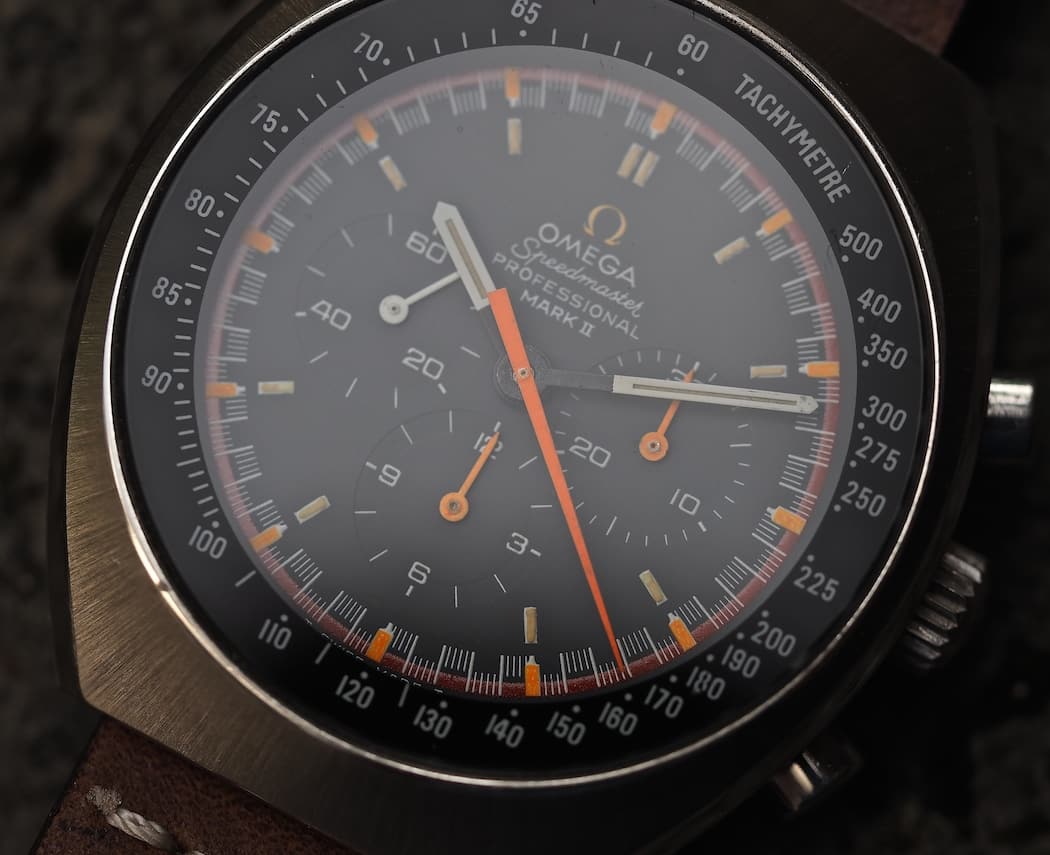
So, yes, the racing dial of the Omega Speedmaster Mark II 145.014 sold me on the watch. It’s a unique blend of orange, white, magenta, and grey that at once feels very much of the times but is clearly coordinated enough to look relevant today. Inside the markers, it’s very much a Speedmaster with the spacing of its sub dials due to the use of the same 861 found in the more traditionally cased Moonwatch. It’s the minute’s track, along with the use of orange chronograph hands that really adds a lot of pop to the dial. Also, Omega employed big white hour and minute hands with grey portions stemming from the center of the dial in order to create a “floating” look. It’s very similar to the visual trick used on the Rolex Explorer 1655.
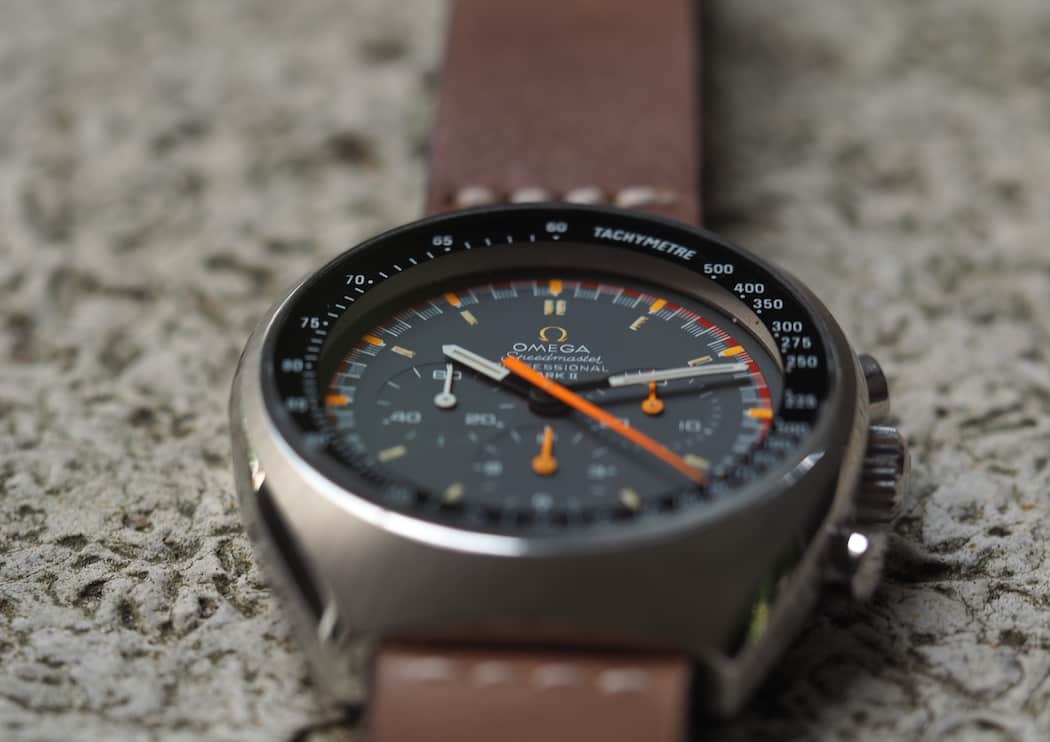
Innovation is a part of the Speedmaster II 145.014 DNA
Another hallmark of the Omega Speedmaster Mark II 145.014 design is its use of an integrated tachymeter bezel. It’s actually printed on the backside of the mineral crystal and as note before, the crystal just barely sits above the case. It’s seamless and must of looked as modern in 1969, or even more so, than when ceramic was first introduced as a common bezel material during the last decade. In fact, I still think that the integrated bezel looks starkly modern today. And then there’s the case…
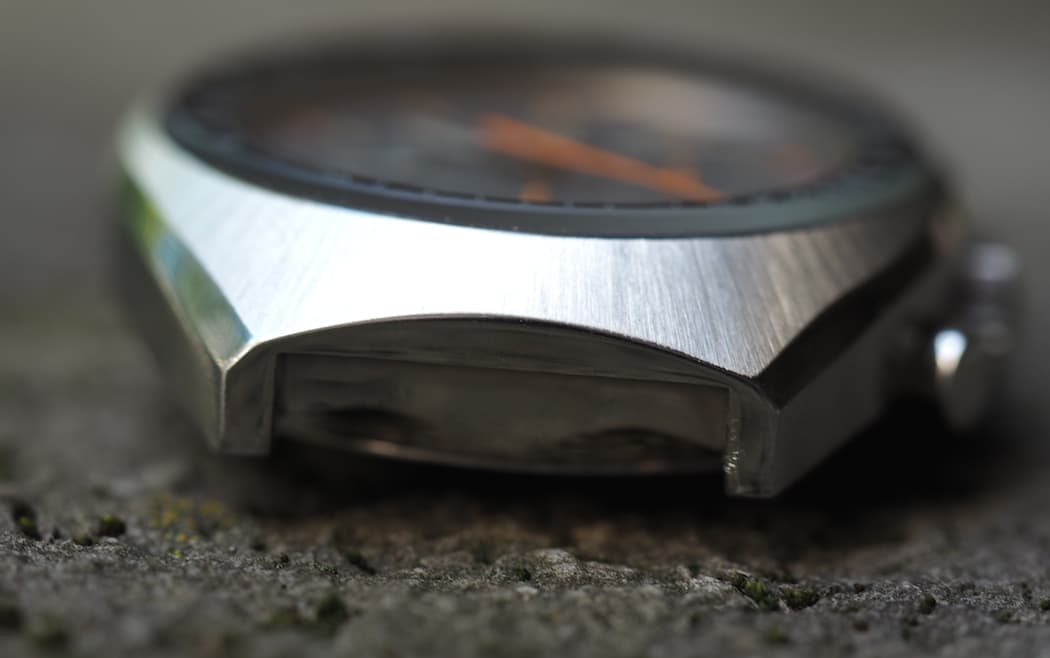
The Omega Speedmaster Mark II 145.014 has a case that’s pretty stunning in person. Sure, it trades the Moonwatch’s lovely lyre lugs for a hooded/hidden design, but it’s lithe versus so many of the bulky, decidedly heavy handed, designs that were to follow by other makers and Omega itself in the decade to come. View the lugs “head on” and one can see that there’s relatively little metal around the lugs themselves. Similarly, view the watch and see the slim case at 9:00. The diameter, incidentally, is around 41.5mm and that actually makes it smaller than the original Professional by 0.5mm. The other key feature found on the case of the Speedy Mark II is the use of what I’d call “sunray” finishing on its top surface. Omega chose to use these fine striations on the surface and have them end sharply onto a transitional polished surface. As we’ll discuss during the restoration section, these surfaces may seem simple, but they’re easily damaged during normal wear. The case back uses the familiar “Pre-Moon” hippocampus and is screw down. Finally, the Speedy Mark II uses a stubbier signed crown and pushers that, by virtue of barely extending past the case, are reasonably protected.
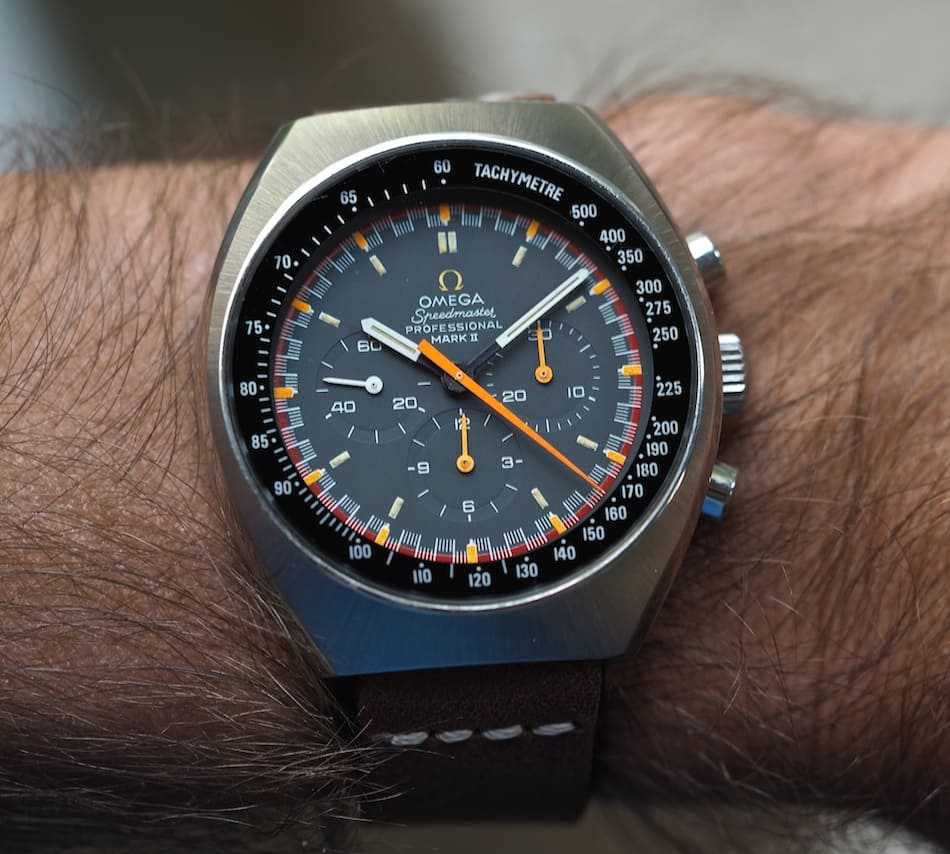
It wears so nicely…
One of the greatest surprises I’ve found with the Omega Speedmaster Mark II 145.014 is how nicely it wears. The watch feels a bit thicker than a standard Professional but it adds to up to a watch that comes off as more robust and solid. Plus, credit the short lugs for a perfect fit on my tiny wrist.
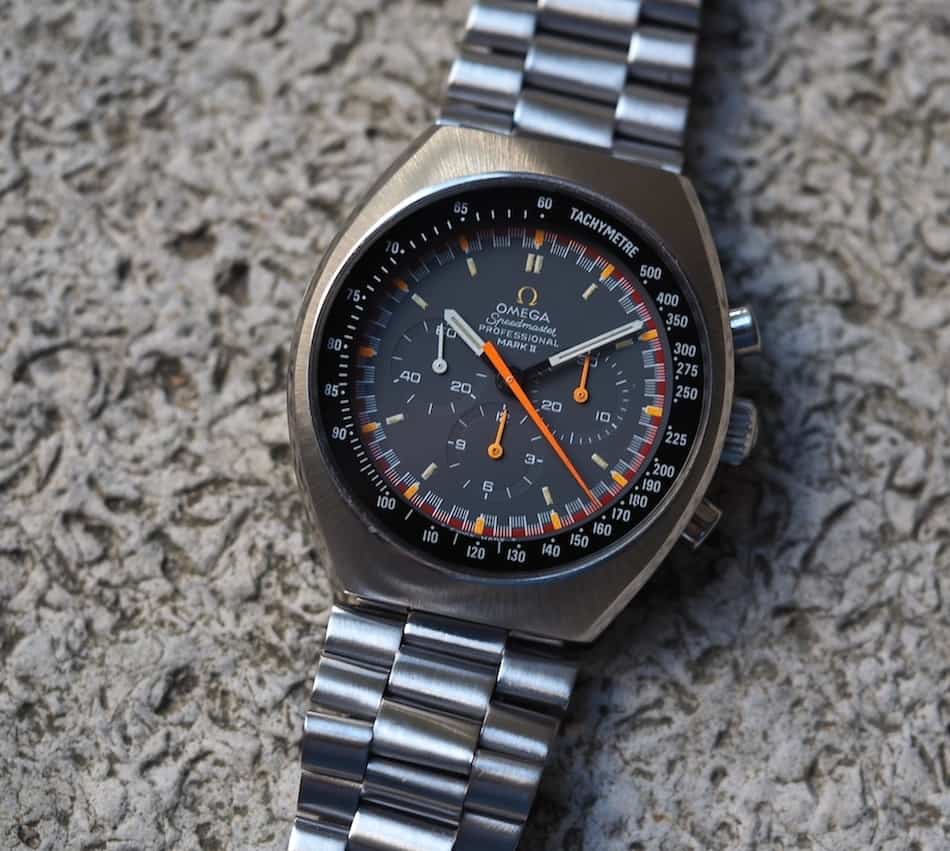
Speaking of this, I received my Omega with an incorrect bracelet, but one that is very similar to one of the two correct references used on this model. What I’ve discovered from Omega bracelets after, say, 1968 or so when the 1039 was discontinued, is that Omega switched to bracelets that feature a more dramatic taper in link width shortly after the clasp. Strangely, Omega often included enough links for me to remove in order to fit my wrist, but in doing so, the remaining links were too wide to fit under the clasp. Confounding! The result is one that has me flummoxed with this (as well as with my 166.073 Seamaster 120) Speedmaster. I’ve used a generic bracelet similar to the correct Omega and it looks good, but I am strangely enjoying the watch on the 20mm brown strap you see here. This is an oddity to me as I always felt the Speedy Mark II belonged on a bracelet or nothing, but the strap is good in person. I’ve also been told to cut down a 22mm strap to fit the lugs, which should provide enough width after to match the case. Who knows? The other option may be mesh, but let’s see.
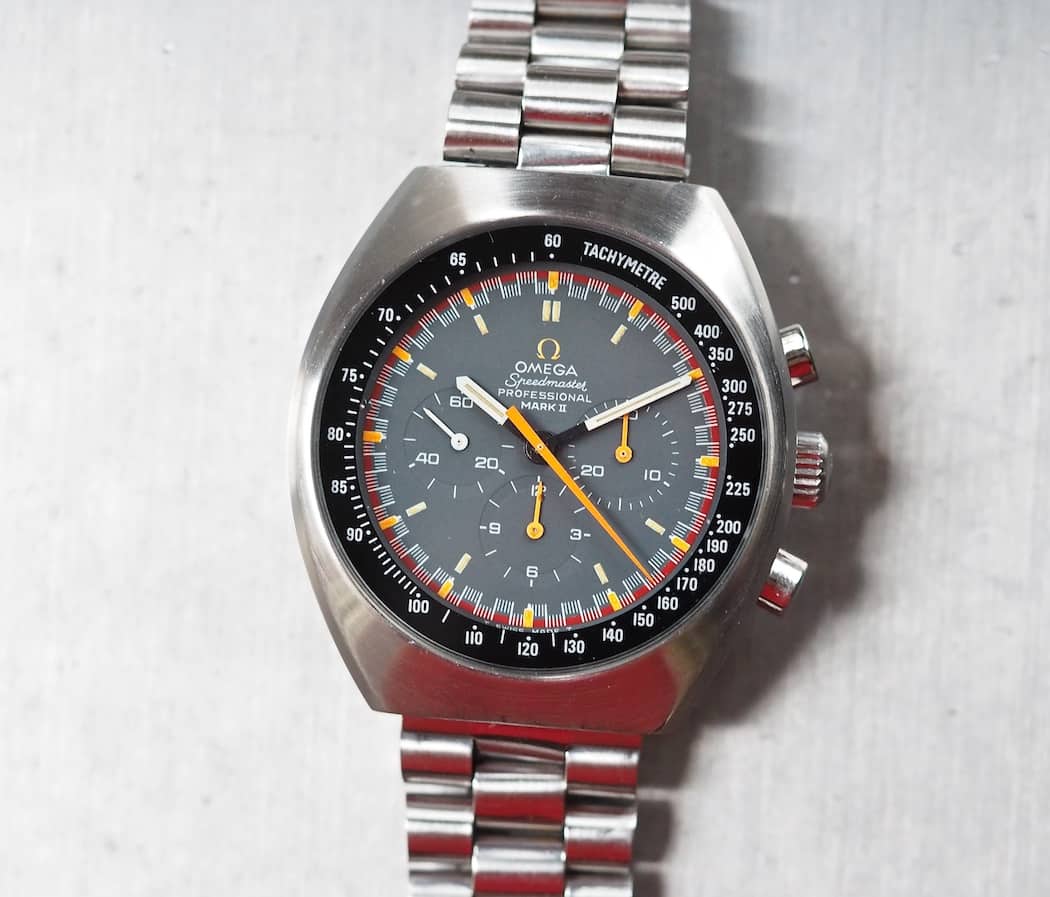
Lapping Machine
It was actually Robert-Jan who turned me on to the Omega Speedmaster Mark II 145.014 you see on these pages. It was sitting in the Netherlands so he actually had the opportunity to see it in person before giving it the “ok”. He did mention it needed some case refinishing. Oddly, the watch before you arrived in the condition above with radial case polishing. Perhaps the prior owner liked it or this was the only method of refinishing at his disposal, but it was definitely done on purpose. Anyhow, this incorrect finishing plus a wonky pusher required it to be sent back to the Netherlands for a date with a lapping machine and a service. As you can see, the case looks great now with all but the most severe issues resolved. Movement wise, there’s little to discuss on the 861 – it runs like a horse and keeps great time.
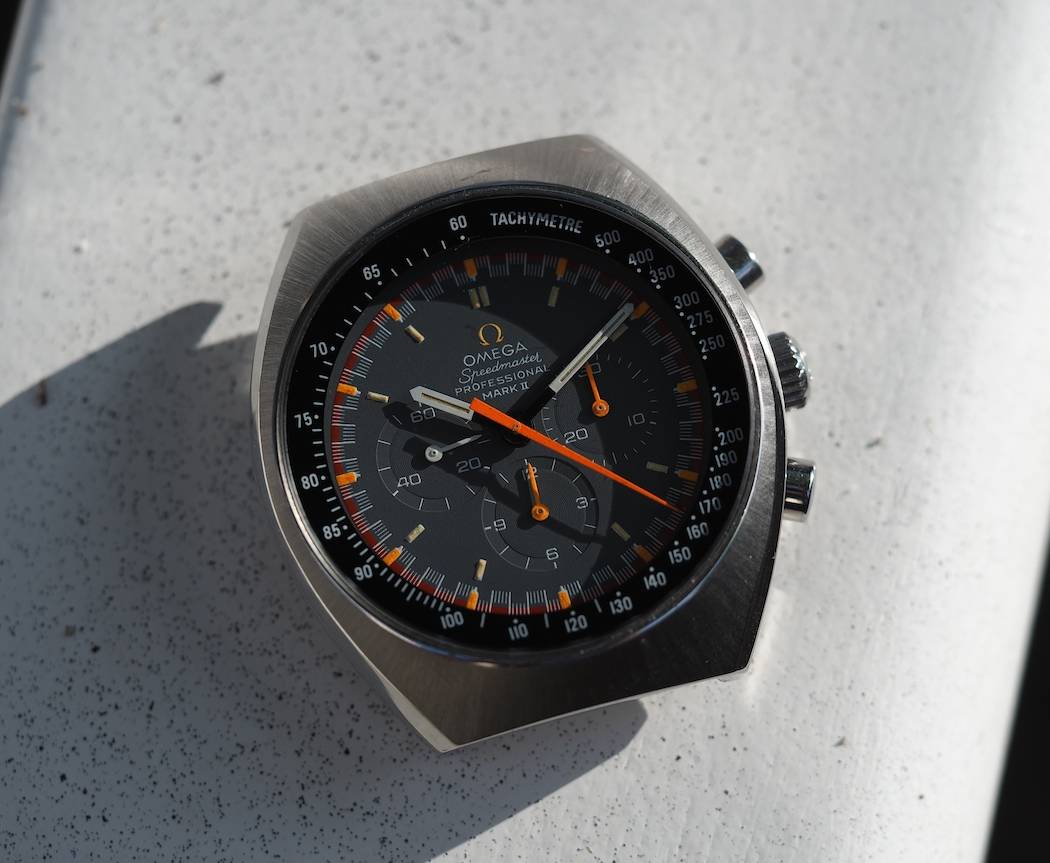
The Omega Speedmaster Mark II is still a serious bargain
So, I kicked off the article talking about how unloved the “Marks” are from the Speedmaster line, but it does seem that they’re slowly catching some fire. I’d argue that the Omega Speedmaster Mark II 145.014 is leading the pack due to its slightly more traditional looks and its inclusion of a manual wind movement. Furthermore, the racing dials seem to be hottest due to the current interest in exotic chronographs and they truly have become harder to source. I can recall ten years ago seeing Speedy Mark II’s for $700-1100 all day long. The odd bargain does show up from time to time, but it’s becoming increasingly rare to find a good racing dial Speedy Mark II, much less any Speedy Mark II, for under $2,000 and $2,500 is beginning to find acceptance.
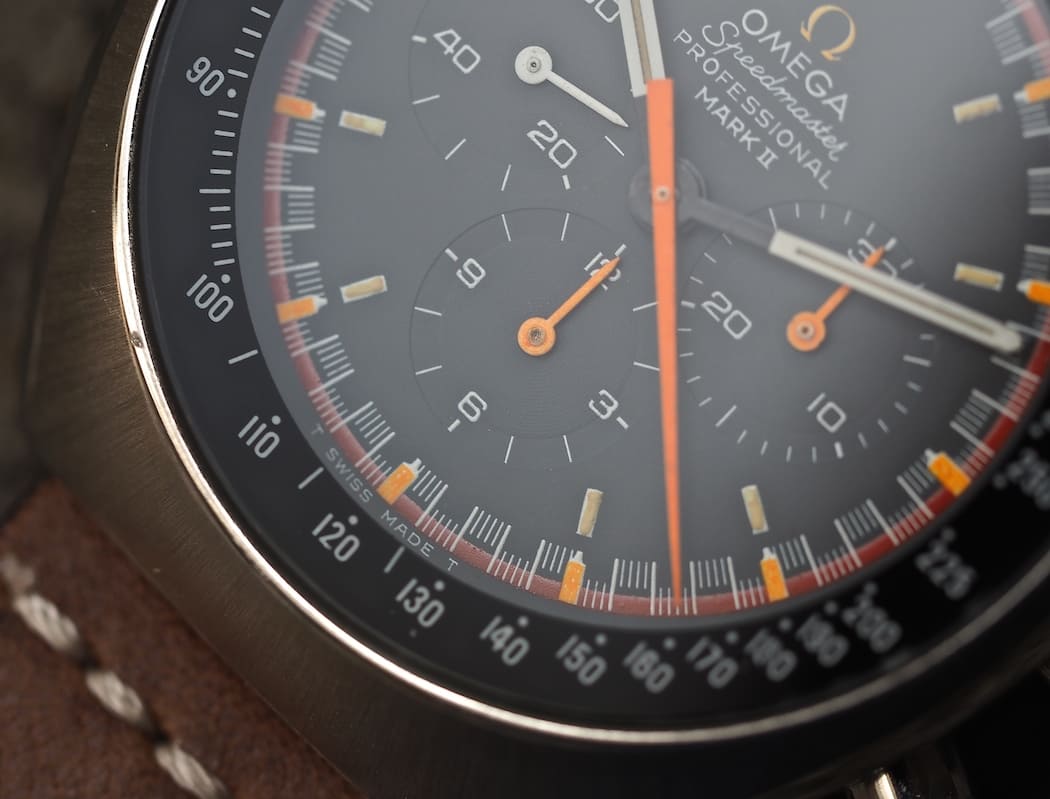
No DON
Watches under these price levels tend to have problems and the biggest issue is that dials have often been replaced and lack the “T” for tritium at the bottom of the dial. I’ve also seen a rash of racing dialed pieces with orange hour and minute hands coming from a similar era Seamaster chronograph; these simply aren’t correct. Also, ensure that the subdial hands are correct (orange for the hours and minutes and white for the running seconds). Owners will often try to pass off a formerly black dialed version as a racing dial when they simply swap the dial and can’t find the right hands. One nice thing about the Omega Speedmaster Mark II is that crystals are available and from what I can gather, there’s no difference between service and original (no Dot Over Ninety issue here!). As mentioned, case condition is something to check because buying a badly polished watch that’s beyond saving really ruins the experience. Thankfully, movements are easily serviced. The major positive for the Speedy Mark II is that during its roughly 4 year production run, it was popular and watches are out there – so be patient.
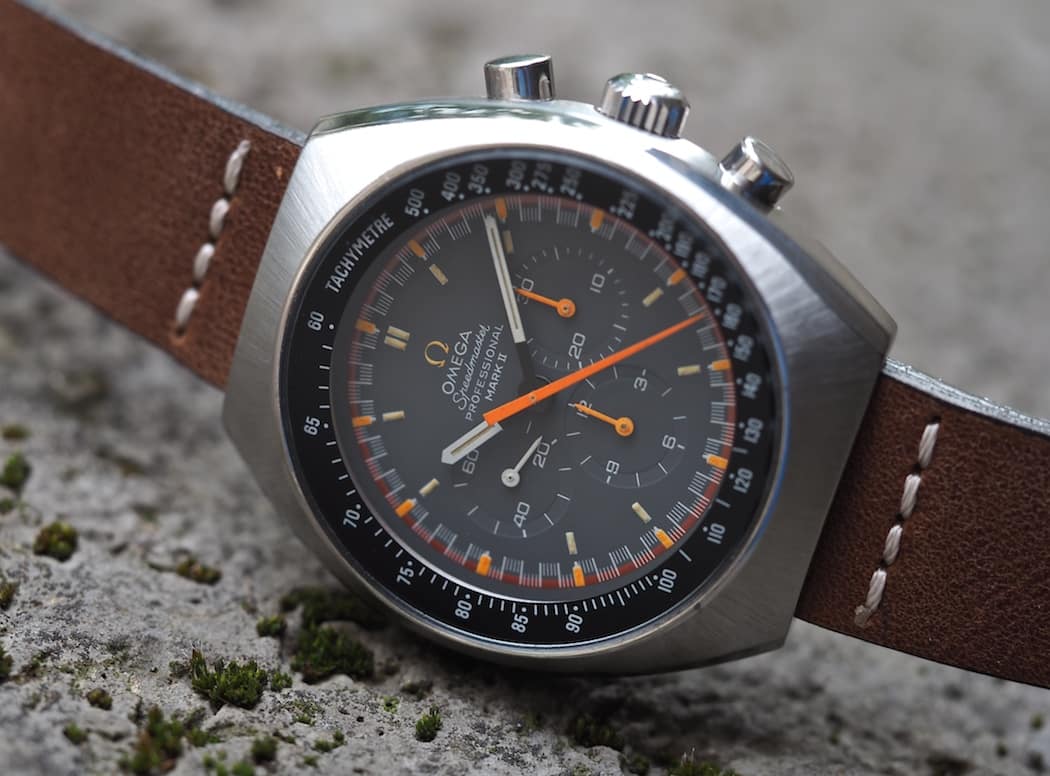
Collectible or Not?
The Omega Speedmaster Mark II 145.014 is really a watch that deserves far more credit. It was innovative with its new style of case and bezel design, was seemingly purposely built to go to space, and it’s made from robust, proven hardware. I also see it as highly significant within the Speedmaster’s lineage. Add the allure of the racing dial version, and it’s a compelling watch that can still be sourced at absolute bargain prices considering the ridiculous vintage chronograph market. It’s a great watch for the beginner collector as well as one who has a vast collection of either/and vintage chronographs or Speedmasters. There’s a lot of conjecture as to whether this watch will truly become collectible, as it has languished for so long, but, then again, even “normal” vintage Speedmasters were not so highly regarded a short time ago. Just look at them now…




















